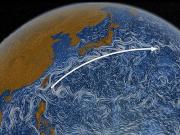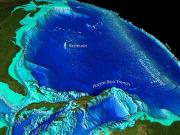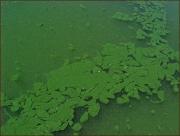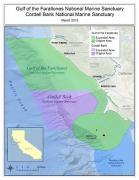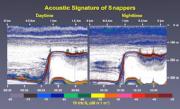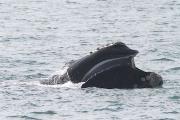Radio Program
Our regular Science and the SeaTM radio program presents marine science topics in an engaging two-minute story format. Our script writers gather ideas for the radio program from the University of Texas Marine Science Institute's researchers and from our very popular college class, Introduction to Oceanography, which we teach to hundreds of non-science majors at The University of Texas at Austin every year. Our radio programs are distributed at to commercial and public radio stations across the country.
For most of us in the United States, no ocean current is better known than the Gulf Stream. It begins in the Gulf of Mexico, flows up the eastern seaboard, then crosses the Atlantic to Europe. Its warm waters help regulate temperatures across two continents.
Seaweed is hot. Or, if you prefer, you can have it cold. No matter how you like it, though, seaweed is becoming more popular in the United States and other countries around the world. It’s served in salads and main courses, and it’s ground up to use as seasoning. And an extract from seaweed forms a thickener in gelatins and a binder in toothpaste.
But the name “seaweed” is a bit misleading. That’s because, unlike land-based weeds, it doesn’t have roots or stems or leaves. Instead, seaweed is a type of algae. It absorbs nutrients and water directly from the saltwater around it.
The ocean surface is bumpy. Big mounds of water can rise up to hundreds of feet high. No one notices them because they’re many miles wide, so their slopes are gentle. They are detected, though, by orbiting satellites. And scientists can use the satellite measurements to learn about what’s far below the bumps — on the ocean floor.
Iron is crucial to your health. It helps carry oxygen through the body, so if you don’t have enough, you feel tired and sluggish. But too much iron isn’t good, either; in some cases, it can lead to diabetes or even heart failure.
The same thing applies to much of the microscopic life in the oceans: Iron is a key nutrient, but too much of a good thing can be bad. Overdoses of iron in single-celled organisms more than two billion years ago may have slowed the evolution of Earth’s atmosphere.
Any marine creature that wants a bit of privacy would be well advised to avoid Cordell Bank, a submerged mound off the coast of northern California. Life is so abundant that, in places, corals, sponges, crabs, sea stars, and other organisms pile atop each other two or three deep, covering every square foot of sea floor. Fish fill the water above them, with whales and other mammals passing through as well.
In fact, Cordell Bank is one of the busiest marine habitats in the world. And it recently received some extra protection.
The oceans are getting louder. Fish and mammals grunt, click, and chirp to attract mates, threaten rivals, or just say “howdy.” At times, though, they can be overpowered by the sounds created by humans. It’s enough to drive a fish to distraction.
To understand just how distracting human-made noise can be, scientists first must understand how marine organisms deal with the natural “soundscape” — the sounds produced by the creatures themselves. A recent study, for example, found that fish seem to talk over each other during the daytime, but share the soundscape at night.
More than 2,000 years ago, a Roman ship was headed home with an amazing array of treasures when it sank off a Greek island. Today, scientists are exploring the wreck with an amazing array of technologies — including the “Iron Man” of the deep.
Researchers may not be ready to hold a conversation with them just yet, but they say they can identify a small group of right whales just by the sounds of their voices. That may provide new insights into the behavior of these endangered giants.
When a major oil spill takes place at sea, a whole army of experts and volunteers mobilizes to clean things up. The teams use several techniques to soak up the oil, suck it up, or even gobble it up. And in a few years, they may be able to add one more weapon to their arsenal: a type of net that captures the oil but allows water to flow right through.
For those of us who have a tough enough time getting around on two legs, trying to coordinate eight limbs sounds just about impossible. Yet the octopus does it all the time — it uses eight “arms” to crawl across the ocean floor. And some recent research says that crawling motion may not be all that complicated — the octopus decides which way it wants to go, then just pushes off.
Scientists recorded the motions of crawling octopuses, then looked at the video frame by frame. And they found that there are two keys to the way an octopus crawls.

